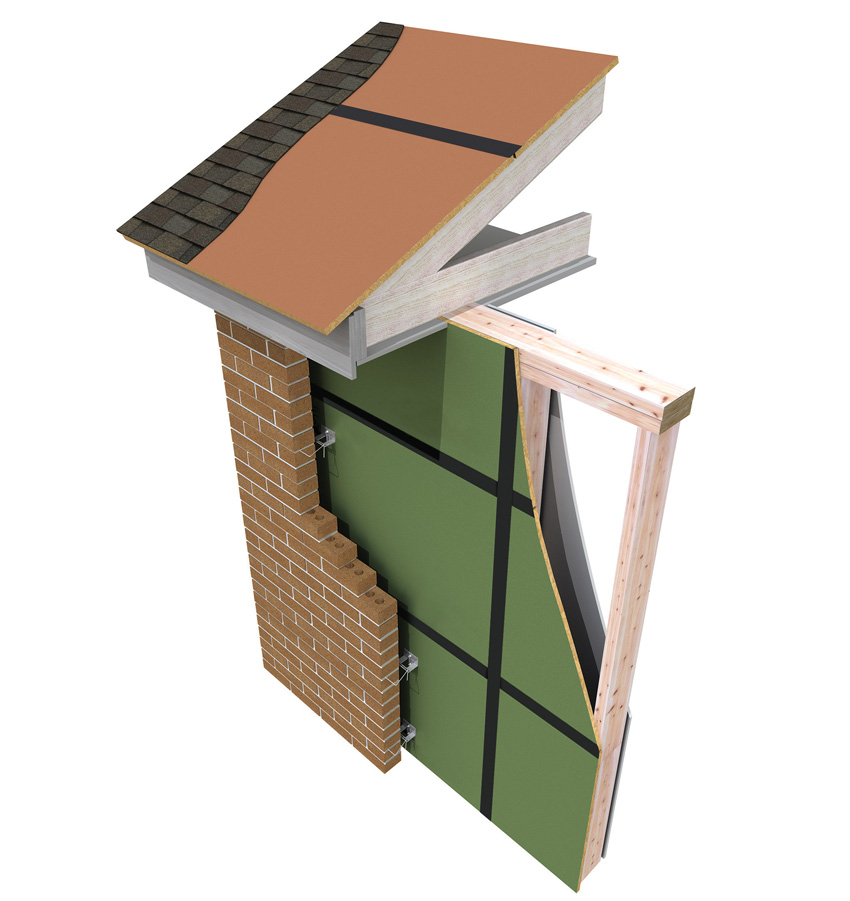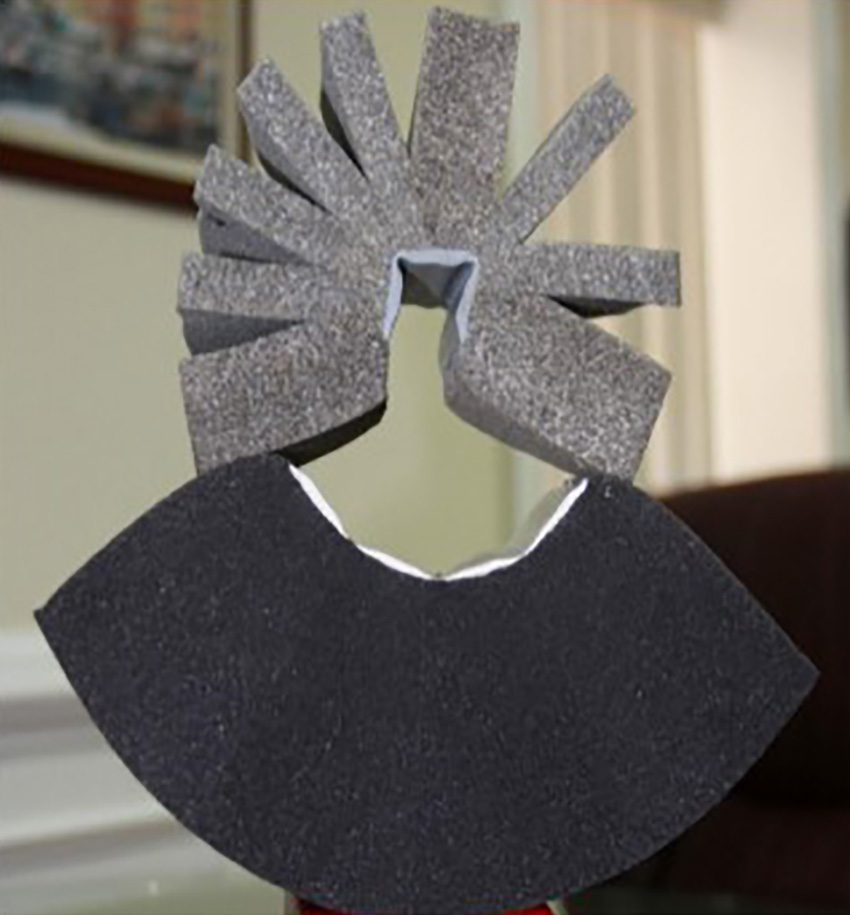Integrated Approaches to Control Moisture in Buildings
Integrated Sheathing Systems Performance
The key to creating a high-performance, wood-framed exterior wall or roof assembly with integrated engineered-wood sheathing is to understand how the different capabilities work together as a complete system. Some of the key points are as follows:
Structure: Integrated engineered-wood sheathing can be specified to provide a Structural 1 panel grade rating, indicating the ability to withstand enhanced racking force or provide a higher shear capacity. This characteristic allows for more design flexibility when designing expansive spaces or walls with more windows because of the documented allowable shear capacity. This panel grade rating is also recommended in APA guidelines when used behind stucco assemblies with a vertical panel orientation.
WRB and air-barrier integrity: Because the WRB and air barrier are manufactured into the panel, integrated sheathing and coordinated tape provides better quality control because nothing is hidden behind a wrap, a spray, or a roll on. This makes everything very easy to inspect in the field, and any imperfections can be easily and readily dealt with. In addition, some new installation tools leave a Z-shaped impression on the tape to let supervisors know the pressure-activated tape has been properly rolled.
Thermal performance option: Many design teams are challenged to create more efficient thermal envelopes using fairly traditional wood-framed construction technique, particularly when continuous insulation is called for over the face of wood studs. Toward that end, some integrated engineered-wood sheathing products are available that include a layer of continuous insulation preapplied in the factory. The thickness, and therefore the R-value, of that insulation can be specified to suit different project conditions, but in all cases, the sheathing and the fastening are engineered to retain structural capabilities and thermal resistance. Selecting this additional thermal capability helps comply with energy codes, ASHRAE standards, or voluntary rating systems to reduce thermal bridging and increase energy performance in buildings.
Installation efficiency: Installing a single material with multiple capabilities is obviously more efficient than installing multiple products each with a single capability. In order to determine how much efficiency can be gained, a third-party test conducted by Home Innovation Research Labs looked at the difference between achieving rough dry-in using integrated sheathing and tape versus traditional housewrap and tape. Its findings showed the integrated system and tape allowed crews to seal the building 40 percent faster than the housewrap and tape.
Training and support: Manufacturers of integrated engineered-wood sheathing and tape products recognize the need for designers and construction crews to learn more about the ways to optimize the use of the various product options. Therefore, they offer the support of a professional team of experts who provide product knowledge sessions (some offering continuing education credits), consulting on design, specifications, or code compliance, and preconstruction meeting support. At least one manufacturer also includes a mobile classroom as part of its technical support that provides job-site installation training and course completion certificates, as well as mock wall training demonstrations.

Image courtesy of Huber Engineered Woods © 2017
A fully integrated sheathing system combines structure, water-resistant barrier, air barrier, and optional thermal barrier all in fewer steps for both wood-framed wall and roof assemblies.
Overall, switching from specifying and installing multiple single products to a system with integrated layers can create some learning curve. However, once understood, project managers and subcontracting teams tend to prefer the more streamlined approach and higher quality control that can result. Aaron Mathews, director of commercial sales with Huber Engineered Woods, points out, “The suite of engineered wood sheathing products with integrated control layers were developed at the intersection of building science and industry need. They enable projects to be dried in faster and reduce risk of repair delays while providing an effective long-term system to manage water, air, and thermal bridging.”
“There are a lot of great water-management products on the market,” he adds. “The best one is the one that’s installed properly,” he continues. “That’s why these products come with full-scope support from design consultation, preconstruction input, code compliance expertise, and on-the-job training to help provide the right information at the right time throughout the project.”
Expansion Joint Performance
When looking at expansion joint selection and specification for assuring continuous sealing in buildings, the following should be considered.
Nominal joint size: The design width of an expansion joint at an average air temperature is usually determined by a structural engineer and referred to as the nominal joint width. The selection of all joint systems, whether caulking, cover, or concealing systems, starts with understanding the nominal joint size and the range of movement between the minimum fully contracted size and the maximum fully expanded size. The expansion joint system selected needs to accommodate this full movement range.
Type of movement: Building sections can move due to several common reasons. Thermal movements are most typical and caused by daily environmental temperature changes in and around the structure. Thermal movement is primarily one directional in nature and is the result of the expansion and contraction of structural elements as affected by heat, cold, and humidity levels. The amount of thermal movement is typically approximately 10–25 percent of the nominal joint size. Seismic activity can also be a source of movement, which may be horizontal, vertical, in shear, or a combination of all three. Seismic joint widths may need to increase with higher floor levels to protect a structure during earthquakes or other seismic events. These joints must have the capacity for movement of approximately 50–100 percent of the nominal width. Finally, wind-load-induced movement caused by high winds can cause a structure to sway back and forth. Such wind-load-induced movement can be perpendicular or parallel to the joint.
Applications and location: The project scope could include interior and exterior joints or both. Typically, the joints need to run continuously through all adjacent planes to fully separate building sections and allow independent movement in things like building veneers, soffits, parking decks, patios, roofing systems, etc.
Form and appearance: This item usually depends on the adjacent finishes. There may be different design criteria for back-of-house conditions, public corridors, or high-end spaces. Depending on the aesthetic, there are options for incorporating interior finishes into the joint system, such as applying anodized finishes or coatings, or using colored foam seals to complement the decor, provide an accent or minimize sightlines.
Material makeup: If foam seals are being considered for use, it is important to recognize that there are two ways to manufacture these with different performance results. One approach is to create a monolithic foam seal of the needed width and depth. The other is to laminate different layers of foam together to create the needed size. While in a compressed state, it is true that any of these foam seals may look the same, but they do not perform the same over time. Architects should look closely at the way a foam seal is manufactured and ask questions of the manufacturer as to its makeup. Laminating multiple ½-inch layers of foam together is a cheaper manufacturing process but can result in a product with reduced life cycle due to the vulnerability of delamination of the various layers from each other or susceptibility to splitting from shear movement. For all of these reasons, specifications calling for foam seals made with “monolithic manufacturing methods” will more likely avoid product failures and claims for damages during the service life of the building.

Photo courtesy of Inpro
Monolithic foam seals for expansion joints, shown on the bottom of this photo, provide long-term, durable, and waterproof solutions. Laminated foam seals, shown in the top of this photo, are subject to delamination and failure when used in an expansion joint system.
With the above considerations taken into account, the selection of expansion joint systems can be worked into specifications and construction drawings to help assure the building project is properly allowed to move, remains weather and moisture tight, and protects life safety.
Conclusion
Water and moisture control in a building needs to be addressed throughout the entire design and construction of a building. The systems described here—foundations, wood-framed walls, and expansion joints—all provide good insights into the nature of the issues and the types of integrated solutions available to help with creating continuous barriers. Incorporating these high-performance systems will help buildings to be more durable and less vulnerable to moisture and water damage. The principles behind these three systems should be sought for other products and systems in a building project too for a fully continuous, cohesive design and construction.
Peter J. Arsenault, FAIA, NCARB, LEED AP, is a nationally known architect, consultant, continuing education presenter, and prolific author advancing building performance through better design. www.pjaarch.com, www.linkedin.com/in/pjaarch

|

|

|
Notice

www.inprocorp.com

www.xypex.com

InsulateYourBuild.com








